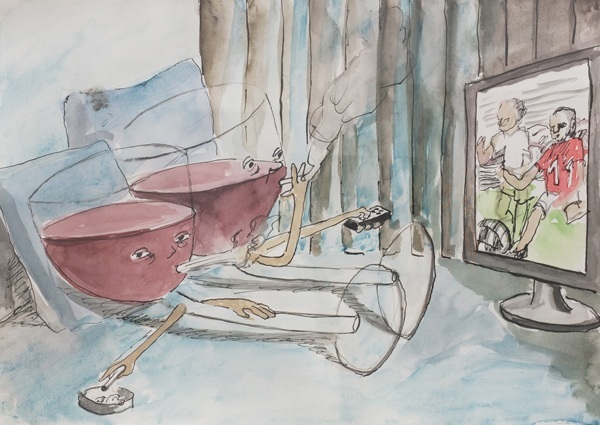Extend the term medium beyond grammar and tonal scales, beyond oil paint and choreography, beyond newsprint, cartoons, and political machinations, and it ends—or begins—with the body, our first and most foundational means of relation with the world. In The Boundaries of Gender, the first of this year’s four special issues exploring real and imagined borders, we’ve preempted the primary concerns of any publication—the message—to first consider the source of all human connection—the medium, the human body. As anthropologist Angela Zito has written, the action of creating our self through the body “paradoxically takes place at its edges, on its surfaces, and through its senses, which act as gates to the outside world. The implications for the construction of gender,” she continues, are that nothing is ever fixed. To have interior selves, we must first reckon with our own exterior selves and the borders that separate the two: “There is no boundary unless there is the possibility of its transgression.”
And transgress we do. With flourish, defiance, trepidation, and wonder. In this issue we’ve upended the constricting binaries of man:woman, straight:queer, to explore what lies between. After all, Guernica has always existed at the borderlands and the interstices; inquiries about gender and its fluctuations are at home here. We acknowledge in this special that the boundaries of gender (and therefore of ourselves) are forever most provocative and engaging when we are crossing, passing, and flat-out defying them.
Author Maggie Nelson, in an interview with Guernica’s Ariel Lewiton, discusses anticipating the birth of a son with her fluidly gendered partner, and her new book, The Argonauts, reminding us that there’s nothing new about the shifting sands of gender. “The truth is that we are all changing all the time to each other,” she says. It’s not about the pronouns, the denotations, but about context. In the parable that Nelson names her work for, “all of the parts of the Argo can be changed so every part of the ship is no longer the original ship. And yet it’s still called the Argo, much like our bodies and selves are replacing all the time.”
Alexander Chee describes his own liberating experience of “passing” as a woman—perhaps even as a white woman. Chee tentatively selects which physical attributes “make up” his gender by deciding which moles on his face to pronounce and which to obscure. “I choose one on my upper lip, to the right, where everyone inserts a beauty mark. I have one already, it feels like a prophecy. I dot it with a pencil.” It’s Halloween in San Francisco and Chee is in love, on the streets, for the first time performing against the rigid boundaries that have always constrained him. And yet he knows that he is only partially able to determine how others perceive him.
Iranian journalist Habibe Jafarian writes that she learned early on that working in her home country meant employing all the attributes of gender she could. She is afraid and defiant, she is assertive and ever sensitive to the restrictions of her culture. “I stay [in Iran] because, as my mother never stopped repeating, I am my own woman, but also my own man.”
Chika Unigwe tells the fabulous story of Mama Paulina, a widowed mother of two in Unigwe’s native Nigeria who draws on long-standing traditions to upend patriarchal rights of inheritance by marrying a woman. And Shanoor Seervai interviews activist Laxmi Narayan Tripathi about India’s new rights designations for the hijra community, the members of the country’s third gender. “It’s not about getting breasts or having SRS [sexual reassignment surgery]. First we need our rights. We need our dignity. We need inclusion in every bloody policy for the marginalized.”
New poetry from Boston Gordon and Elizabeth Lindsey Rogers asks what is permissible and for how long. “Think that even in another body, even after / that barter with the mud wasp and surgeon, / you would still not be settled,” writes Gorden in “The Body.” And artist Hayv Kahraman’s show How Iraqi Are You? uses ancient, sacred texts—in a language she must relearn after years in the US—to explore national and gender identity. Kahraman, in an interview with Guernica’s Alex Zafiris, talks about persistent discrimination, being a refugee, and the aftereffects of violence.
The issue also features an interview by Brian Gresko with psychologist Ronald Levant about his scholarship on masculinity and fatherhood, including theories of the way “gender roles are artificially imposed on children.” Gender, he tells us, is constantly constructed and reconstructed. “When adults buy into traditional masculine or feminine ideologies, they rear their children to conform to those norms…. Given that aggression is a masculine norm, it’s no surprise that 87 percent of the violent crime committed in this country is committed by boys and men.”
We have new fiction by Lee Conell that probes vulnerability and our collective and personal responsibility for discrimination, and by Carter Sickels that parses the endless varieties of gender and sexuality we inevitably course through via our encounters with attraction… and other wildernesses. Plus, Anne Boyer on medicine and the female body, and Benjamin Percy visits Man Camp.
Features:
Chika Unigwe: The Transformation of Mama Paulina
Habibe Jafarian, translated from the Persian by Salar Abdoh: How to Be a Woman in Tehran
Anne Boyer: Data’s Work Is Never Done
Interviews:
Boys Don’t Cry: Brian Gresko interviews Ronald Levant
Inflections Forever New: Ariel Lewiton interviews Maggie Nelson
India’s Third Gender: Shanoor Seervai interviews Laxmi Narayan Tripathi
Art:
Inside / Outside: Alex Zafiris interviews Hayv Kahraman
Fiction:
Poetry:
